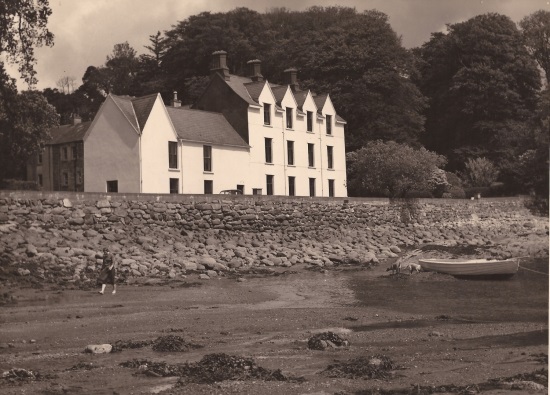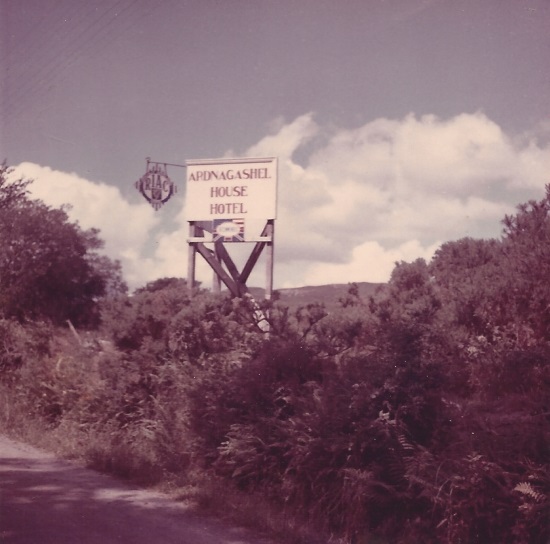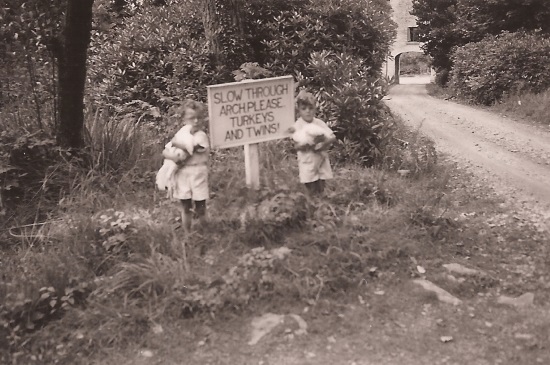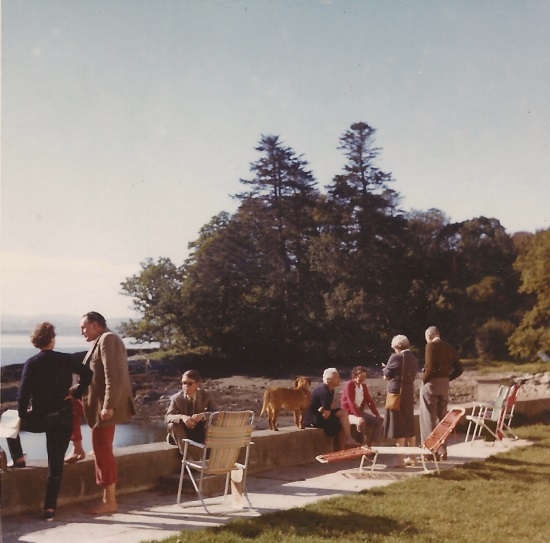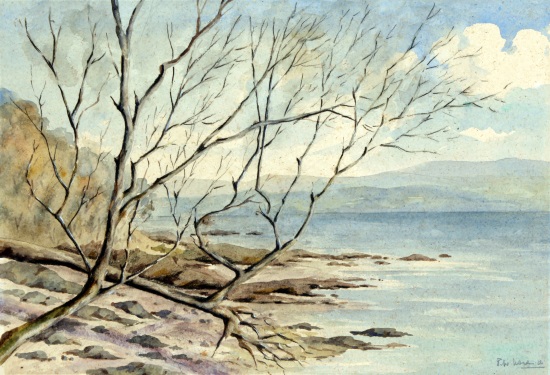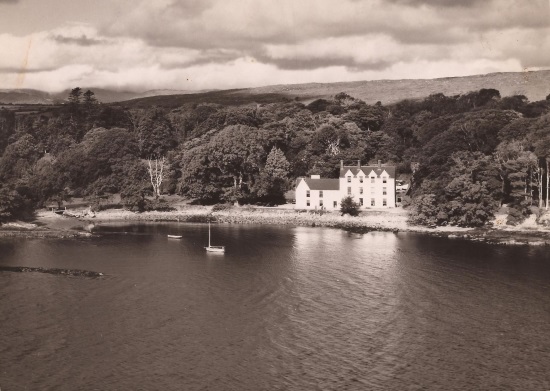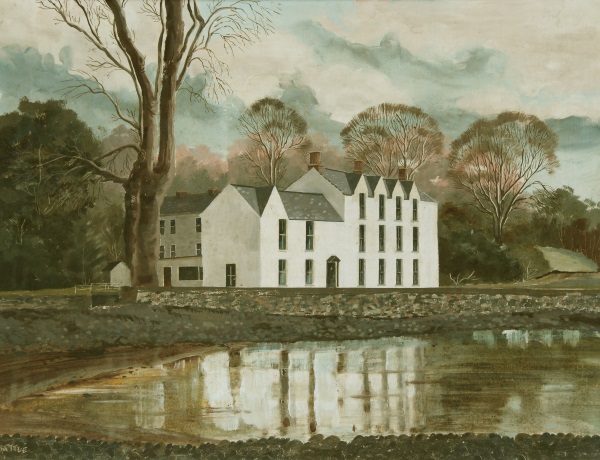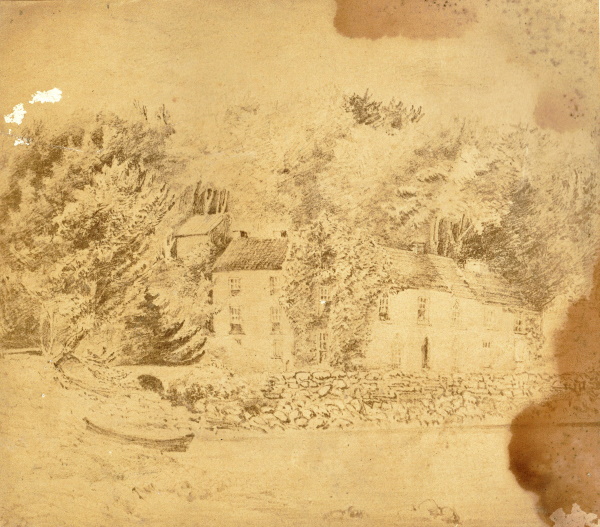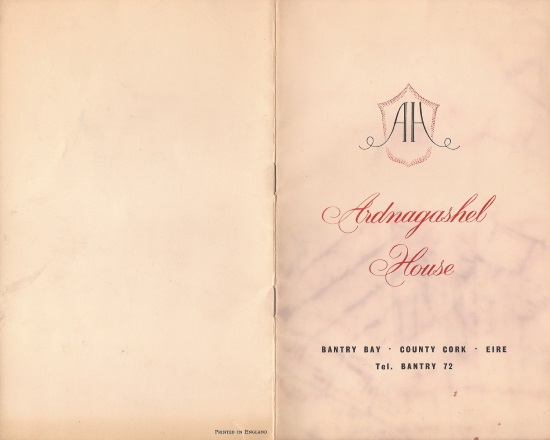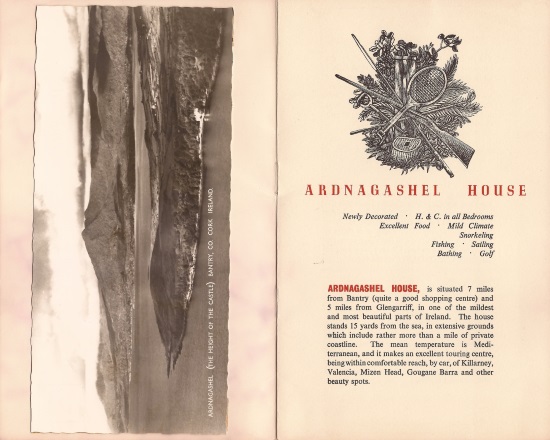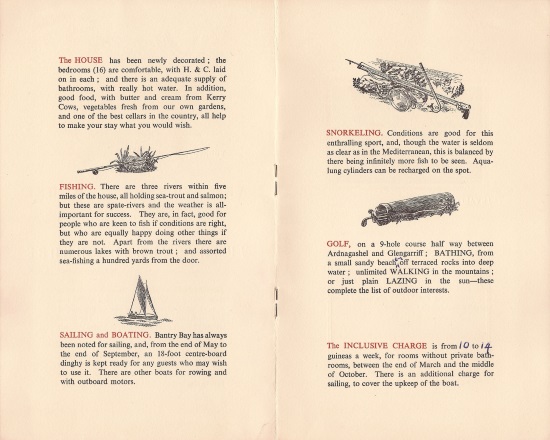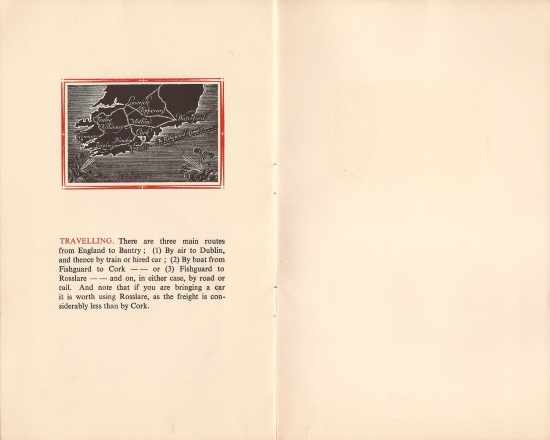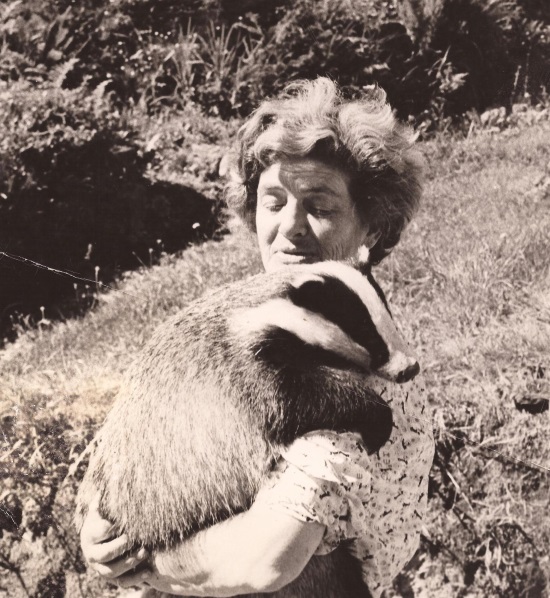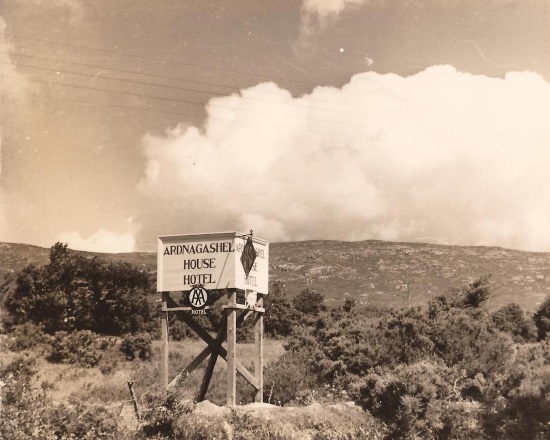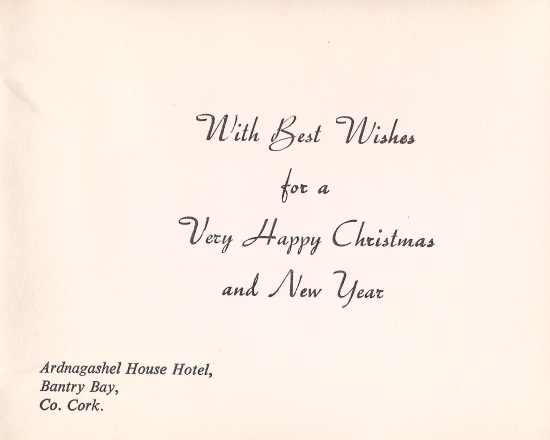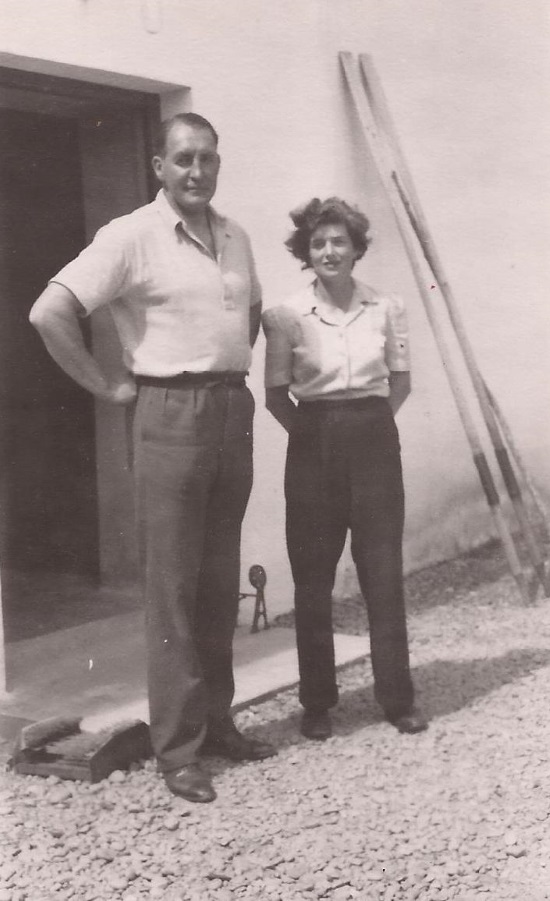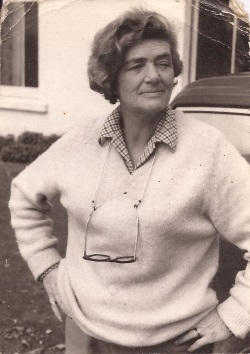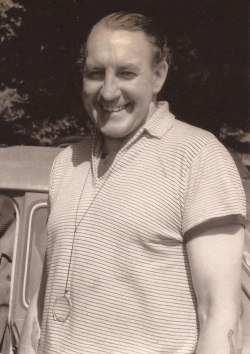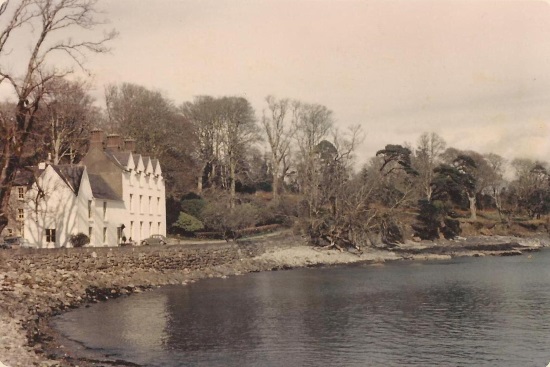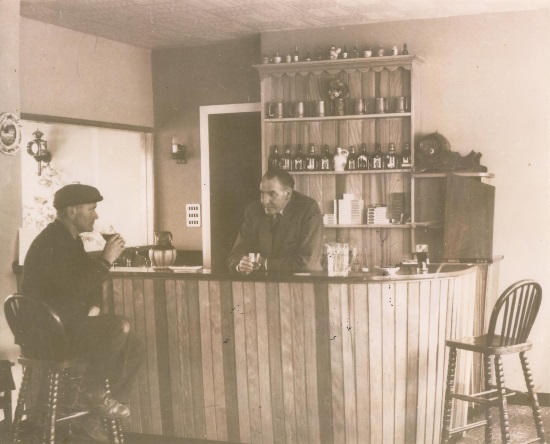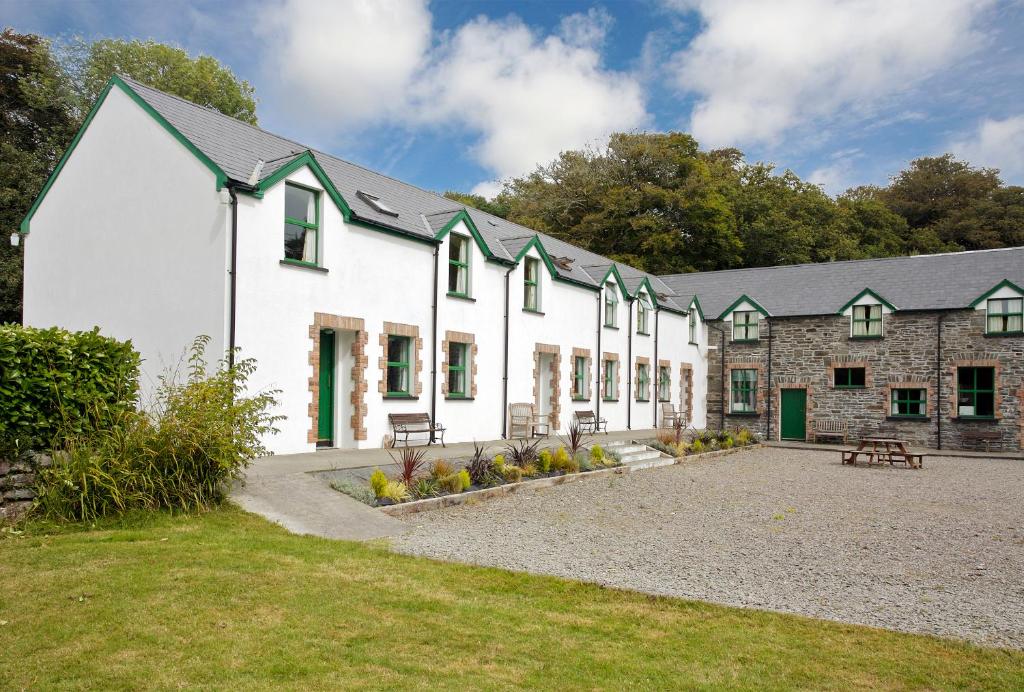Zeitgeist
A place, a house, latterly a hotel, but primarily a state of mind for all who knew it at its zenith in the first two or three decades after the Second War.
Because of its definitive bearing on the lives of those who still remember it, I held back from any attempt to present its narrative until I could do it justice, and that was not so at the time the photograph above was posted (ca 2012). Since then, however, a great deal of material has come to light, and is presented below.
But I'd like to retain the links to the really excellent websites of Eliane Zimmerman, who is so immensely knowledgeable about the tradition of the great house, the grounds that still surround it, and indeed so much of that Atlantic coast of Ireland.
www.wanderlust.ie
scents-and-senses.blogspot.com
ardnagashel.wordpress.com/the-hutchins/the-hutchins-family
ardnagashel.wordpress.com/the-hutchins/ellen-hutchins
ardnagashel.wordpress.com/the-estate
ardnagashel.wordpress.com/the-kaulbacks/ronald-kaulback
ardnagashel.wordpress.com/the-kaulbacks/audrey-kaulback
ardnagashel.wordpress.com/the-kaulbacks/the-hotel
Ardnagashel approaches
On returning from sojourns in Abu Dhabi and Athens, I made contact with Sonia Kaulback again, and she impulsively suggested that I join her for a week or two back at the old homestead in Bantry. Penniless and bedraggled though I was, I rashly agreed and off we went by train to Fishguard, then ferry (the old Innisfallen) to Cork, and rural coach to Bantry and just beyond ...
The first thing I saw from the coach, wedged uncomfortably as I was between a goat and a nun, was the towering stone arch at the entrance to the Ardnagashel driveway from the main road, as we approached from Bantry. This is it, exclaimed Sonia, come on, hurry up, get off or we'll miss it!
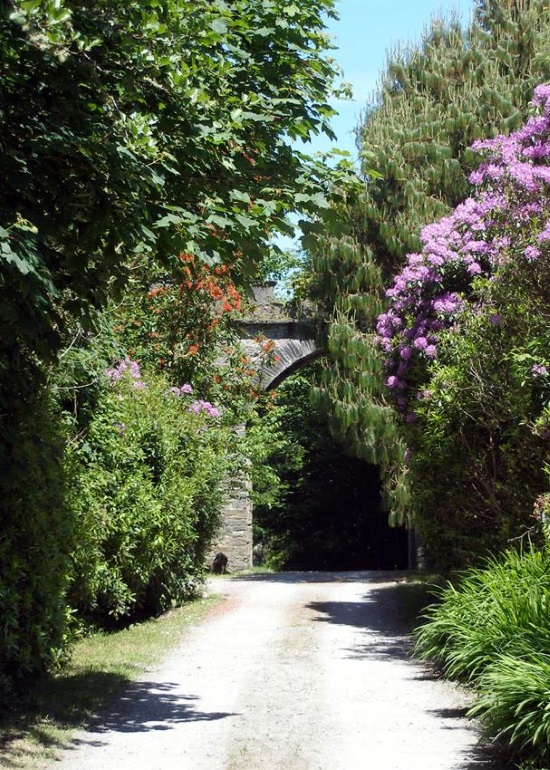
Sincere thanks to Eliane Zimmermann for this recent photograph.
The arch is now rather picturesquely overgrown with trees and flowering shrubs
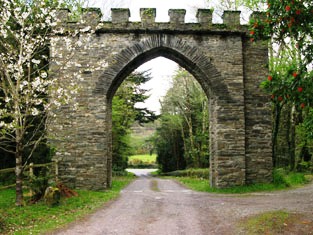
Seen from the other side.
It's clearly further from the road than I remember.
Had we been approaching from Glengarriff, in the opposite direction, the roadside hoarding would have provided an advance warning to look lively.
Looking lively has never been my forte in life, and I prefer to let my real merits, poor things but mine own, gradually impress themselves on those around me.
It's better to live down a poor first impression that to fail to live up to a deceptively good first impression, in my opinion. Better a crescendo than a diminuendo.
So by the time I emerged from the bus clutching my meagre possessions, Sonia was already almost out of sight, eager to be reunited with her parents. I followed stolidly, unsure of what was to manifest itself.
The renowned 'Turkeys and Twins' sign was a good omen, and the arch beyond led to a spacious yard, the nearer side of which was flanked by a long two-storey stone building in which (as I later learned) the family lived and the hotel laundry and other services were located. But neither turkeys nor twins were in evidence just then.
The drive now swooped downwards briefly to the left and as it then bounced back to the right, the bay became visible on the one side as the house gradually revealed itself on the other.
Various deck-chaired tweedy figures became visible, flanked by forceful-looking memsahibs with floppy sunhats. Immediately out of my depth socially, I nevertheless resolved to keep treading water.
It was the beginning of a long and ultimately successful transition from bizarrely clad semi-feral drop-out to at least the outer margins of social acceptability. I was quite articulate, literate and numerate, always a good place to start, but had yet to meet Ron Kaulback.
He was busy in the bar and beamed at Sonia as she bounded in. Hello Dad, she said, I've brought a friend, his name's Robin, his other name's Erskine.
After a stunned silence during which he stared at me aghast (my orange suede bargain winklepickers, 39/6d, were afterwards identified as being the focal point of disbelief), he sufficiently recovered the power of speech to say, Well I shall call him Erskine, and turned back to the bar.
A little later I was also introduced to Audrey; we hit it off at once and I loved her dearly to the end of her days. Indeed, Sonia always told people that I married her for her mother!
At the bottom of the drive, off to the left of that picture above was this fallen tree, with one branch planted amongst the rocks, providing a dizzying route down to the water's edge for more fearless individuals such as Susie and Ron, who could sashay nonchalantly along it without "crooching or stooping", let alone shufflebottoming (on which those with the least head for heights had to rely).
This very nice watercolour was one of many painted by Maj Philip Ironside, who with his wife Betty were frequent visitors from Innishannon. He was also very accomplished at fly-fishing, as was Audrey, with whom it was a great bond. When Sonia was in her late teens, the Ironsides joined her on skiing visits to Austria (she would travel adventurously by train) – Betty didn't ski, and neither did Philip but he ski-bobbed instead, and they all thoroughly enjoyed the cosmopolitan après-ski atmosphere afterwards.
Ardnagashel in a Nutshell
The following synopsis of Ardnagashel's history (up until the game-changing fire of 1968) was prepared by Sir Cosmo Haskard, resident of Tragariff, the great house just down the coast from Ardnagashel. His wife Phillada, Lady Haskard, explained in an accompanying letter of 1998 that he had been asked by the staff of the holiday apartments that had been established in what was previously the yard up above the house, if he could provide some historical background information for a leaflet to be produced in response to the many enquiries from visitors. This he did, as you can see, and the resulting leaflet was a great success.
Ardnagashel gallery
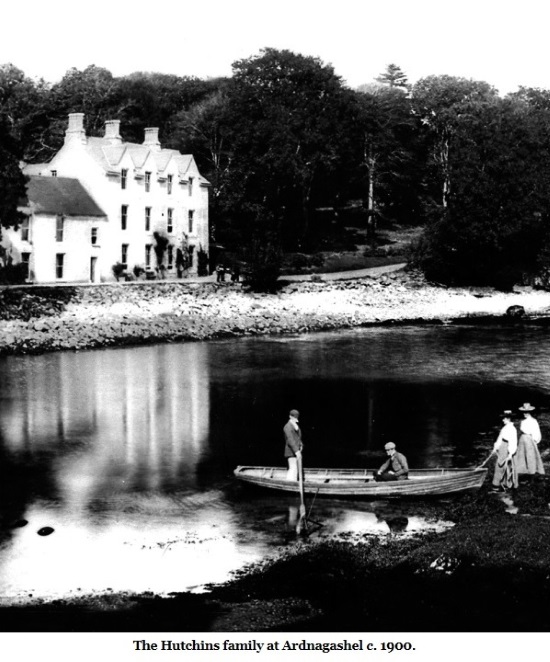
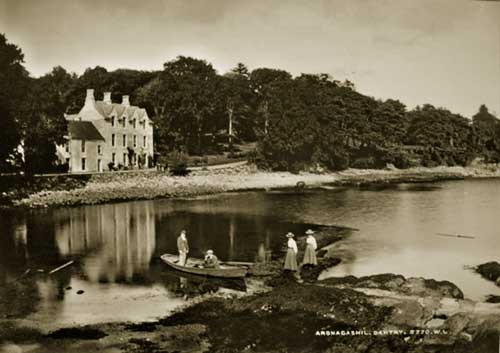
Taken moments afterwards.
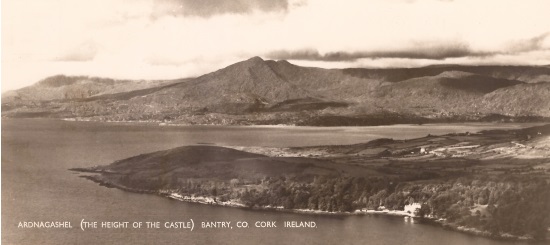
Evidently an aerial photograph and therefore post 1910. Note Ardnagashel House in bottom RHS corner and Sugar Loaf (Gabhal Mhor) dominating the skyline further round the coast.
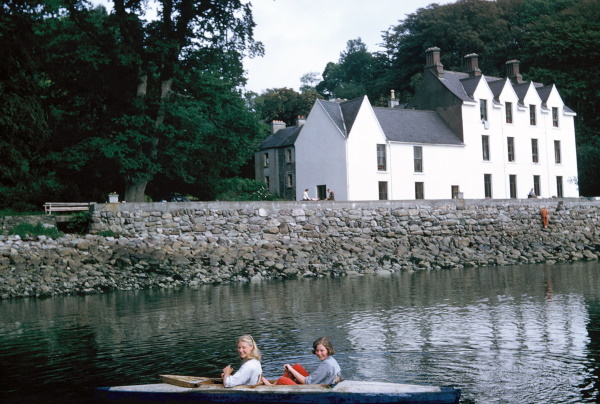
And another, but with colour! In the kayak are Christina and Belinda Cadbury, second and third daughters of Alan and Jane Cadbury. The Kaulbacks and the Cadbury family became very close at that time and thereafter. Sonia and I are very grateful to Stephan Woollcombe for this wonderful picture.
It isn't surprising that Ardnagashel, a starkly angular old house with a turbulent history, in a wild romantic setting, tree-girt and storm-lashed, also attracted artistic attention.
The scraper-board original by Julie Brenan had survived some fairly rough handling, but has photographed very nicely, in conjunction with a touch of digital repair-work here and there. In fact, two variants of this image are also rather compelling, and one starts to wonder where the artistic truth resides in such situations.
A rather striking painting by the quiet and reserved, but very likeable, Edgar Battle (1911 – 15 Apr 1982) who, with his histrionic partner Millie (15 Feb 1915 – 12 Feb 1991), ran the tourist art and souvenir gallery just a bit further up the road to Glengariff from Ardnagashel. The LH side of the photograph is slightly over-cropped, but no matter.
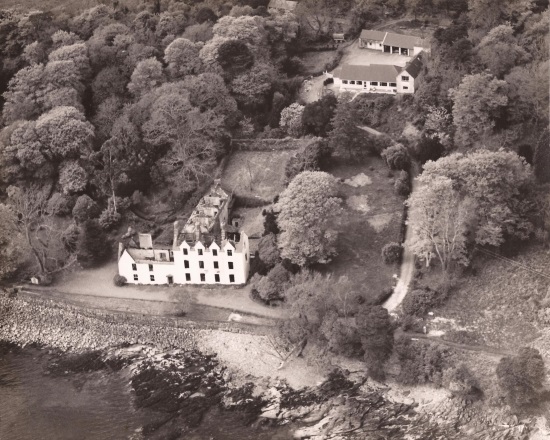
Ca 1972 after the fire (1968), and the building of the restaurant (early 1970s).
The derelict old house was subsequently demolished and rebuilt, by Ron and Audrey, but after their departures the new house was replaced by a succession of architecturally undistinguished bungalows.
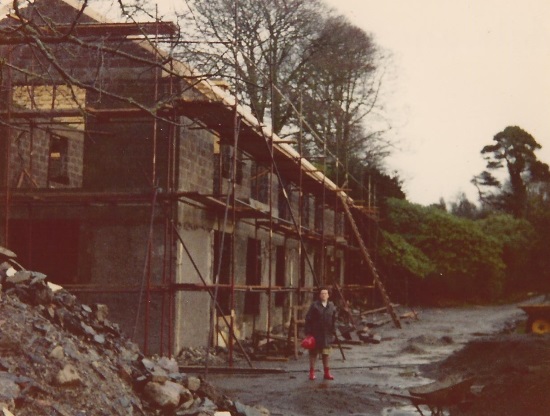
The new house under construction (Christmas 1972) –
note the large pile of rubble on the LHS
from the demolished remains of the old house.

The new house (subsequently demolished under new ownership) –
the steep slope behind meant that the second storey as seen from the front
was accessible at ground level to the rear of the house.
And finally a very puzzling picture recently (Apr 2020) came to light from the Firswood archive - very faded, and very fragile, attached to backing-paper in the last stages of disintegration. (This version is autocorrected – please click here to see the original.)
Is it an image of the modern house (since demolished), as the sea-wall and lack of gables would suggest? But in that case, surely, there would not have been time for that mass of foliage to accumulate at the near corner of the house.
Or is it an image of the old house from early Victorian times, before the upper storey and gables were added? There are certainly signs that the roofing tiles have been removed in preparation for some sort of upward extension. And quite possibly there was a sea-wall in that era too, that got pillaged for building work locally when the house was unoccupied during the Troubles. (Ron did of course have the current one built after he and Audrey arrived in 1946.)
I'm very grateful to Madeline Hutchins for this next image, of a sketch made by the 14 year-old Louisa Hutchins in 1844. This confirms the early existence of a substantial sea-wall, and also supports the idea that the original Ardnagashel House was in fact three closely adjacent buildings that had been knocked into one, the original ridges of the roofs being retained (as can be seen).
Also very noticeable, at least to the expert eye I must concede, are the narrow Gothic windows, later replaced by the broader rectangular Georgian ones to be seen in more recent images of course.
Let's Halt Awhile with Ashley Courtenay
I'd feel confident that Ashley Courtenay, as a gourmet and bon viveur, had been frequenting Ardnagashel from its earliest years under the aegis of Ron and Audrey Kaulback, but the reviews that you may see below are all that I have to hand – his practised pen more easily expresses all the unique facets of Ardnagashel for the visitor or guest than I could ever manage as a minor appendage of the family at that time.
Though the cuisine was superb, and the cellar almost unequalled in the whole of Ireland$, and the atmosphere invariably convivial and, as the evenings in the bar progressed, high-spirited, the bedroom accommodation was Spartan by modern standards – warm and comfortable, of course, but plainly furnished and equipped – personally I much prefer plain to the mock-opulent that is de rigueur nowadays.
The other aspect of Ardnagashel was Ron's patrician indifference to the profit motive – it was often remarked that the bar only made money during the intervals that Ron would be called away by (for example) a call from the Gardai to retrieve a dead body from deep water somewhere down the bay, during which time one of the regulars would deputise behind the bar, charge proper prices, and stop providing drinks on the house to favoured customers, or (for example) free packs of peanuts.
And although (as the sand in my hourglass trickles ever more quickly) I haven't compared the purchasing power of money between then and now, or checked the rates prevailing at the other hotels in the area at the time, I do wonder quite how they could possibly have charged such antiquated prices! Though their tariff did creep up over the five years quoted below, it was still incredibly modest.
$ Cached in some remote and cobwebby corner of Ron's cellar was an antique brandy of such rarity and excellence that the only other extant specimens belonged to the King of Sweden.
Ashley Courtenay's Let's Halt Awhile in Britain and Ireland,
29th Edition, Andre Deutsch, 1962:
Ashley Courtenay's Let's Halt Awhile in Britain and Ireland,
32nd Edition, Barrie & Rockliffe, 1965:
Ashley Courtenay's Let's Halt Awhile... in the British Isles, Eire and the Channel Islands,
34th Edition, Barrie & Rockliffe, 1967:
The cryptic abbreviations were all pretty self explanatory
| Abbreviation | Meaning | Abbreviation | Meaning |
| F.L. | Fully Licensed | 10%S | Service Charge |
| W.T. | Weekly Terms | Rms. | Rooms |
| B.B. | Bed & Breakfast | Sgl. | Single |
| L. | Lunch | Dbl. | Double |
| A.T. | Afternoon Tea | Priv. Bath. | Ensuite |
| D. | Dinner | G. | Garage |
Prices were all pre-decimal, and were expressed in terms of guineas (I guinea = £1.05), shillings (1/ = 1 shilling = £0.05) and [old] pence (1d = 1 old penny = £0.00416rec). So for example, 16 gns meant £16.80, and 37/6 meant £1.875!
From the highways and hedges
As can be seen from the roadside signboard in the photograph further up the page, and the one further down the page, Ardnagashel was recommended by both the RAC (Royal Automobile Club) and the AA (Automobile Association). Even more prestigious in the eyes of French visitors to the area, however, was its gastronomic distinction, as evidenced by this accolade from the Automobile Club du Périgord:
Though the hotel is long gone, the Automobile Club du Périgord itself thankfully continues to flourish.
Brochure
As Uncle Matthew (a thinly-disguised Lord Redesdale, Nancy Mitford's father) put it in The Pursuit of Love, "Frogs are slightly better than Huns or Wops, but abroad is unutterably bloody and foreigners are fiends". We've moved on from those crude caricatures, and personally I think that SW Ireland has everything a civilised person could possibly require – spectacular scenery, wide well-made roads with little traffic, and (often enough) very decent weather, but above all, the Irish people themselves: welcoming, hospitable, articulate, exceptionally well-educated and well-informed, and invariably happy to pass the time of day over a glass of Paddy or Jamesons.
Ardnagashel threw in a host of other activities for the more energetic holiday maker – such a golf, sailing, schnorkelling and even scuba diving. Ron was an accomplished subaqua diver himself, and there was a compressor to refill the air tanks each day.
Oh yes, and there was Ardnagashel's very own fresh farm produce (much of it still rationed in England for years after the war), Cordon Bleu cooking and a cellar almost unrivalled in the whole of Ireland.
Juche
Especially in the earlier and most self-sufficient days of the hotel, Ardnagashel must have had capabilities at least equal to those of many far more established rural communities of that time. And in each and every respect, one can detect the wisdom and ingenuity of Ron Kaulback and indeed Audrey too as she grew in confidence.
There are many verbal accounts that bear this out, some of which I have managed to tease out from Mrs Robin, but getting them down on paper has been a different matter until now.
A recent one she’s recollected concerns the pigs Arsenic and Old Lace (named for the smash-hit US movie of 1944, starring Cary Grant) who lived in a sty up in the yard, and whose function in life was to consume the daily left-overs from the Ardnagashel dining-room.
Somebody, quite possibly Winston Churchill, once remarked that dogs looked up to you, and cats looked down on you, but pigs were equals. And Ron was very happy to maintain a ruminative rapport with the two porkers, of an evening, doubtless scratching their backs in a soothing sort of way – just as Clarence, the 9th Earl of Emsworth, would have done with the Empress of Blandings in the incomparable narratives of P G Wodehouse, the author to whom the Kaulback family was so close.
Ron could never resist a spoonerism, however, and he generally referred to them as Knicks and Old Arse.
A flock of chickens, with attendant cockerel, was kept too, as witness the story of Mumtaz Mahal in A family interlude. Turkeys too, as evidenced in Slow through the Arch, Bryan (on the LHS of the two), nominally the elder twin, though developmentally the later one, developed rather a gourmet taste for turkey-droppings!
Robin has asked me to think about some of the ways in which Ardnagashel was self-sufficient. We certainly had to be in the early days, when it was difficult to source all that was necessary for the smooth running of the hotel and the feeding of its guests.
To start with, I remember Dad set up our own generator to provide us with electricity - and this continued until we were able to join a national grid some years later. Also I well remember how we would frequently run out of water during dry summers, and Susie and I would be allowed to skip lessons and ride on the tractor down to the Coomhola River (we loved this!), where barrels would be filled with water and placed on the trailer, and back we would go again. Eventually Mum and Dad got a water diviner to pinpoint a good source of spring water, and an enormous holding tank was built and the hotel never ran out of water again.
We also grew many of our own vegetables, especially ones which in those days were not available locally, such as sweetcorn and garlic. The vegetable gardens were the province of Donal Coakley, while his colleague John Harrington had charge of our herd of lovely black Kerry cows, which provided milk for the hotel. (I had my own little milking stool and was allowed to do my own milking, that is until we invested in automatic milking machines.) We had a beautiful black Kerry bull, and Susie and I used to have fun climbing on the bars of the bull-pen and pretending it was dangerous - although I seem to remember he was a lovely mild creature. Every year each new crop of calves were given names starting with the next letter of the alphabet. On the subject of dairy produce, until interesting cheeses began to be available locally, Dad would make his own Camemberts, and there would always be a number of them resting/maturing on the inner windowsill of the room where all the hotel laundry was dealt with.
For some years we had about 200 hens in an enormous big deep-litter barn (lots of space for the hens to enjoy scratching around in, not like the horrific battery cages in today's factory farms!), and surplus eggs would be sold in shops in Bantry. However, one hen was set upon by the others and her head was so badly pecked that there was in fact a hollow where her brain should have been! Mum filled up the hollow with Zambuk (an antiseptic cream), and Dad named the little hen Mumtaz Mahal (the original MM was the wife of Shah Jehan, who built the Taj Mahal), and ever after she had the run of the farmyard, and was apparently quite happy, although somewhat dim (she would carefully lay her daily egg in the stream nearby!). We also had lovely white turkeys (who inspired the famous notice asking new arrivals to go "Slow Through Arch Please, Turkeys and Twins". And of course there were our two beautiful Muscovy ducks, Melchisadek and Melpomene (Dad was always brilliant at naming our various animal family members). And how could I forget our flock of white Aylesbury ducks, including Jemima (who had a "bonnet" of white down set rakishly on one side of her head) and the drake Donald, who achieved fame by once seeing off a threatening fox; not to mention the two stately Chinese geese, Henry and Henrietta.
Dad used to purchase live lobsters, and we would pop them in a large floating crate, which was anchored in our little bay. The lobsters would live there quite happily until there was a culinary need for them, in which case Susie or I would row out to the crate and extract the necessary number of lobsters and deliver them back to the house. Another happy memory of mine is of Dad in the hotel bar making Pimms No.1s for thirsty customers, and calling out "Daughter, borage please" (borage is the herbal plant with attractive little blue flowers, tasting of cucumber, which add the final touch to a Pimms), and I would dash up to the walled garden and pick all the necessary borage for him. Thinking of the walled garden, I recall how Dad would spend time 'harvesting' all the snails that were lurking in the crannies of the walls - and these snails would in due course be offered with garlic butter as an Ardnagashel delicacy!
Until Robin asked me to think about how self-sufficient Ardnagashel was, I had never really considered how brilliantly Mum and Dad managed, especially in the early days. I am so full of admiration for them.
Glorious food!
Lionel Bart’s best-ever musical, on the subject of food and its consumption, provides the perfect heading for Sonia’s recollections of Ardnagashel’s occasional kitchen crises and their triumphant resolution.
After the first few years, Mum and Dad closed the hotel during the winter as they realised it wasn’t really worth staying open during those months, and at that time they would take a holiday (much needed), visit friends, renovate house and grounds where necessary – and then start the annual task of training new staff for the next season!
Susie and I were at boarding school (good old French School Bray – FSB – near Dublin), but when we were home for the Christmas hols the food was very simple. A cauliflower cheese, for instance, or spaghetti tossed in olive oil and garlic with a green salad. Another simple meal I remember was creamed sweet corn topped with a poached egg.
When the hotel was open, my mother would generally do all the cooking (taught by my father$, since when they married she had never even boiled an egg. The clever girl soon became an amazing cook!). However, there were some seasons when we would have a professional chef, generally German, and I particularly remember Günter Ox and Peter Meinhardt.
Günter was especially memorable for running off, in the middle of the season, with my young brothers’ unprepossessing governess! The main thing I remember about P.M. was that he would let me help him in the kitchen – we would make rich ice-cream, choux pastry for profiteroles etc – and he even named a particular form of potato dish after me – Pommes Sonia – they were rather like Pommes Duchesses, but I was so proud!
It was one of those two chefs, I’m not sure which, who one evening stabbed our kitchen-maid Maureen Regan, in the thigh with a small sharp paring knife! Fortunately dear Maureen didn’t make a fuss – the local doctor stitched her up in no time, and it only caused a small delay in the serving of dinner!
Another time, Mum wasn’t well and had retired to bed (no chef that year), and so a splendid young man Hamish (who was helping in the hotel) and I invented a lot of dishes (ham with cherry sauce was one!) and the menu consequently featured a lot of “such and such Maison” and “such and such à la mode du chef”.
Every day in the school holidays Dad would give me the day’s menu, in French of course, and I would type it out. There would have been a choice of soup, probably a potage and a consommé (which the Irish waitresses would describe to the diners as 'tick' or 'tin'!), followed by an entree, a main course, a sweet, and of course the cheese board. A typical menu could have been as follows:
Pommes Duchesse
Les Legumes du Jour
We kept a big crate floating in the bay filled with lobsters, and when there was a need for one or more of these creatures Sue or I would leap into action, row out to the crate and extract the necessary number of lobsters for the hotel kitchen. (I am horrified at the thought now, but of course in those days I had never even thought of vegetarianism, let alone veganism!)
When the evening had progressed sufficiently that all the diners had been fed, my father would hand over the bar to me (or to another hotel resident if I happened to be away at boarding school) to take charge, while he tucked into his own meal. It was probably the only time that the bar made a profit! In Dad's lovely convivial way he enjoyed saying 'Have this one on me' on every possible occasion, whereas I or the hapless guest bartender would make sure of erring on the right side of the profit line by charging too much rather than risking it being too little.
On the subject of the bar, I enjoy remembering how the local gardai (police) would always ring Ardnagashel up before making a raid (to check drinks were not being served out of hours). Colonel, they would say, we're on our way. Right you are, Dad would reply, and then immediately the bar would be closed and all the guests would decamp elsewhere. In due course the gardai would arrive, have a look around, and announce that all seemed under control; whereupon Dad would offer them a drink, they would accept, the guests would return, and conviviality would reign once more! It was a wonderful system, which worked well.
In the early years of Ardnagashel we kept our own dairy herd (lovely little black cows and a large and reasonably friendly black bull), so we were self-sufficient in milk and other dairy products. I actually had my own little milking stool, and used to help at milking time - and would probably get very much in the way, but I loved it. I also used to help make the butter, turning the handle of the butter churn round and round (and round) until the contents resolved into butter and buttermilk. Mum often won prizes for her butter at the annual agricultural show. Another dairy product was cheese; Dad used to make his own camemberts, which were always a big success with the house guests. However, eventually milk, butter and cheese became easier to source locally, and so we did not need to produce our own any more.
$ Ron Kaulback would have been entirely familiar with Johnson’s observation that “He who does not mind his belly, will hardly mind anything else” and Napoleon’s maxim that “An army marches on its stomach”, and would have heartily agreed with them both. His interest in good food, and its importance in human affairs, was first stirred by family holidays in France, where food is of paramount importance at all levels of society, much more so than at home or boarding school! After leaving Rugby he spent several months in India before going up to Cambridge, and his interest in exotic ingredients, strange spices and unaccustomed flavours most probably began at that time.
And of course his expeditions to Tibet and to Upper Burma (in particular) in the mid and late1930’s would have been critically dependent on the rations available, and the capabilities of the camp cook, each and every evening! Those of you who have read his Journals of the Third Expedition will confirm just how much of his daily record was focussed on the quantity and quality of the chow that had been procured that day.
And so it’s not really surprising that he was so well qualified to acquaint Audrey with so many important aspects of kitchen capabilities – particularly as she had of course been bringing up their family on the home front while he was driving back the enemy in the Far East!
Ron’s Kitchen
Who could say where Ron gathered his recipes – during his travels, or from newspaper cuttings, or simply by trial and error (by means of which humanity has progressed from the primaeval dark ages towards an even darker age in which we subsist on Big Macs and French Fries)?
In the interim, and especially in his twenty or so years of retirement after Ardnagashel, he would have fine-tuned all his favourites, and from those recommended the very best to family (Sonia in particular) and friends.
As was the practice of their social background, he and Joyce would give dinner-parties for near on half a dozen guests at a time, accounting for the prevalence of recipes for six or eight people. I think Joyce would have taken care of the logistics, but the curry was Ron’s domain.
Having decided on the recipe some days beforehand, the preparations began, and proceeded day by day with the utmost precision. He would sit at the far corner of the large sunny Altbough kitchen, propping himself on a high stool as he’d lost a leg in rather unusual circumstances some years previously. Peering intently through his half-frame spectacles, occasionally adding a pinch of this or that, stirring intently the while, he gradually brought base ingredients to a state of culinary perfection.
The recipes detailed below were selected and typed especially for Sonia, at various times as you can tell, and enclosed with family news and suchlike in his letters. And they are all (more or less) vegetarian, in that they don’t involve fish, flesh or fowl.
Of course, there are nine and ninety ways of reciting tribal lays, and every single one of them is right. And similarly of course, there are self-styled vegetarians who just don’t eat red meat. And those who eat eggs (ovarians), or fish (pescivarians), or dairy produce such as milk, cream or cheese (lactarians), or white meat such as pork, veal or chicken (be very careful in Chinese restaurants). I think it was George Bernard Shaw who said that he refused to eat anything he could stroke, but Google can’t find the quote.
Most abstemious of all are the vegans, who eat (or drink) only plant-based food (including water of course and, thank goodness, alcohol). I myself am a de facto vegan, as Sonia does the cooking, but am allowed milk on my cornflakes, and the occasional fried-egg sandwich.
But be assured that dairy (cream or cheese) are the only non-vegan ingredients in these recipes, and perfectly viable vegan equivalents are available from any supermarket these days.
VEGETABLE CURRY I
VEGETABLE CURRY II
GRATIN DE RIZ ET DE COURGETTES
RICE WITH SPINACH
JERUSALEM ARTICHOKE SOUP
WHITE SORREL SOUP
TOMATO SAUCE
FRIED MUSHROOMS IN SOUR CREAM
SWEET POTATO CASSEROLE
FRIJOLES REFRITOS
GERIATRIC CARROTS
GLAZED BABY CARROTS
RICE AND VEGETABLES
INDIAN SPICED RICE
NEPALI VEGETABLE CURRY
SWEDES AND MUSHROOMS
CARROTS AND COURGETTES IN GORGONZOLA SAUCE
PURÉE OF CARROTS
CAULIFLOWER, TOMATO & GREEN PEA CURRY
CHESTNUT AND RED WINE PATE
And here’s a tail-ender from way back,
Please note that in every case the size and positioning of the text can easily be adjusted by Ctrl + Mouse-wheel.
Audrey's Kitchen
Ardnagashel House Recipes
John McKenna
It says all you need to know about the critical reputation of Ardnagashel House that, in the early 1970s, it was one of only three Irish addresses to have recipes described in the Good Food Guide Dinner Party Book, first published in 1971. The other two Irish addresses were Snaffles of Dublin and the legendary Ballymaloe House of east Cork.
Mrs Kaulback’s three recipes [though Audrey herself always used the slightly archaic term “receipts”] show the imaginative flavour of the house style: fresh grapefruit and crab salad; caneton aux olives, an elegant stew of duck with olives stuffed with pimentos; and a scrummy dessert of Ambroisie de pêches, peaches and bananas dressed with lemon juice and shredded coconut and served with whipped cream. Any of these dishes could be served today with appropriate culinary pride.
Ardnagashel House was also famous for one of the very finest wine lists in Ireland.
Fresh Grapefruit and Crab Salad
| ¾ | fresh, cooked crab |
| 4 | sticks celery |
| 2 | grapefruit
salt, pepper |
| ¾ | pint mayonnaise
lettuce |
Break the crab into pieces. Dice the celery. Peel the grapefruit, remove all pith and cut the flesh into segments. Put some aside for decoration. Fold the crab and celery into the mayonnaise and add seasoning. Then add the grapefruit segments and toss lightly.
Line a dish with a bed of lettuce, cover with the salad and garnish with grapefruit segments.
Caneton aux Olives
| 1 | duckling, about 3.5 lb dressed weight
salt, pepper |
For the stock | |
| the carcase and giblets | |
| 1 or 2 shallots or 1 small onion | |
| bay leaf
sprig of thyme a few parsley stalks a few peppercorns | |
| ½ | pint water |
For the sauce | |
| 3 | tablesp flour |
| ½ | pint dry white wine |
| 24-30 olives stuffed with pimento | |
Carve the duckling into four – two breasts and two legs. Sprinkle the joints with salt and pepper and put them in a roasting tin in the middle of a moderate oven (375°F, mark 5) for 25 minutes, to crisp the skin and release some of the fat.
While they are roasting, make some stock with the carcase, giblets, some shallots or an onion, herbs, and enough water to cover. Bring these to the boil, skim, partially cover the pan, and leave the stock to simmer.
Remove the duck from the oven, reduce the heat to 300°F, mark 2, and put the pieces into a warmed casserole. Pour off nearly all the fat from the roasting tin and stir into the remainder two tablespoonfuls of flour. Cook over a medium flame until the flour is a rich, dark brown, then blend in half a pint of the strained duck stock and the white wine and bring to the boil, stirring continuously. Add the seasoning and any juices from the duck.
Pour the sauce over the duck in the casserole and put it back in the oven for 20 minutes. By this time the sauce should be simmering gently; if it is cooking too fast, reduce the oven heat to 275°F, mark 1. Cook for a further 40 minutes, adding the stuffed olives, halved crossways, halfway through.
Ambroisie de pêches
[In mythology ambrosia was food for the gods; nowadays it’s any enticing dish with a delicious flavour .... Unfortunately the recipe has been badly photocopied, and has had to be imaginatively reconstructed.]
| [4] | large or 4 small peaches |
| [2] | large bananas
tablesp caster sugar tablesp fresh lemon juice |
| [? oz] | shredded coconut |
| [? oz] | whipped cream |
Skin the peaches by plunging them into boiling water for a minute and then into cold water. Cut them into slices. Peel the bananas and slice them.
Sprinkle the sugar and lemon juice over the fruit and toss them [together]. Chill in the refrigerator for half an hour at least.
Just before serving, mix in the shredded coconut and divide [?] among four glasses. Pipe or spoon whipped cream over the top.
Kaulback kitchens cont p94
The tradition continues...
Well-known guests and visitors
In the list that follows, in no particular order, are just some of the prominent individuals who stayed at Ardnagashel over the years.
Noël Streatfeild (popular author(ess) of such classics as Ballet Shoes)
Clement Attlee (Deputy UK Prime Minister during WWII, Prime Minister 1945-1951, keen Scrabble player with Bryan and Peter!)
Queen Juliana of The Netherlands (who reigned from 1948 until 1980)
Cecil Woodham-Smith (historian and biographer)
Éamonn de Valera (Taoiseach, leading Irish statesman for over half a century)
Joyce Grenfell (immensely popular musical entertainer and national treasure)
Mazo de la Roche (leading Canadian novelist for many years)
Peter Scott (son of the explorer, iconic ornithologist & conservationist)
Thomas Pakenham (historian and arborist)
Maj General Brian Wainwright (ornithologist, Warden of Colchester wildfowl reserve) and Lady Nancy Craven
Jocelyn Woollcombe (post-war Director of the legendary WRNS, blessed like her brother Geoff with a merry sense of humour, and always known as DJ)
And so many other exceptionally interesting and congenial individuals and their families – such as Sir David Huddie and family, who returned year after year, as did the Hills and the Woollcombes.
There were also of course many local notables who very much enjoyed an evening in the Ardnagashel bar – such as
William Bridges-Adams 1 (theatre critic and humorous versifier)
Lieut General Adrian Carton de Wiart 1 (legendary British professional soldier having a lot in common with Ron Kaulback himself)
Kaulback's Cave
A working reserve of wines and spirits for the day-to-day requirements of restaurant and bar was maintained in a room down in the house next to the kitchen. But the cellar itself was a room up in the yard, from which Ron would replenish the room next to the kitchen each morning.
For whatever reason – trust in the total integrity of the Ardnagashel staff, for whom he would organise transport to and from Mass each Sunday, or simply a desire not to become paranoid about security – he didn't lock the cellar door during the first few years of the hotel. But one morning he discovered that the cellar had been broken into during the night and all the spirits had gone.
Circumstantial evidence, or rumour, suggested that the culprit was the husband of the cook at the time, and regarded locally as a Bad Lot. The cook was probably asked a few searching questions and maybe the Guardaí were informed. Be that as it may, the Ardnagashel family dogs were lethally poisoned shortly afterwards, and the suspect left the area, never to return as far as I know.
And the cellar was kept padlocked in between visits ever after.
Its contents were authoritatively said to be the most extensive in Ireland apart from some super-plush place in Dublin. And yet Kaulback retailed them at scarcely break-even prices – as a renowned connoisseur himself, he simply wanted to share them with other appreciative enthusiasts.
Note that the prices are quoted in decimals, and therefore reflect the decimalisation of the Irish punt on 15 Feb 1971 (the punt being pegged to the pound sterling in those pre-euro days).
So these are the prices that were being charged in the new restaurant that was opened in the early 1970's after the hotel itself was destroyed by fire in 1968, of course. But the pricing would have been similarly rock-bottom in the heyday of the hotel ...
No wonder, therefore, that there was invariably a merry buzz of animated conversation in the bar as evening progressed, but when Audrey came in to feed her wild badgers, Fogarty and Milligan (see Puckoon) there would be a breathless hush while everybody watched with fascination. They would arrive from outside when she called, and after eating their fill would disappear out into the darkness again.
And on another occasion, one of the stalwarts of the establishment, though confined to his wheelchair by polio (still not uncommon in those days), came back from the little loo round the corner, and exclaimed "Good God, Ron, there's a frog in the bowl!". General scepticism prevailed, but upon investigation it proved sober fact.
This wasn't the only time that local fauna turned up in the smallest room. Some time thereafter, the same chap, Geoff Woollcombe, returned ashen-faced to the bar and announced there was a hedgehog in occupation. So ever afterwards, a sign attached to the door warned well-lubricated customers to "Cave Ericium"!
Brocklets in the Bar
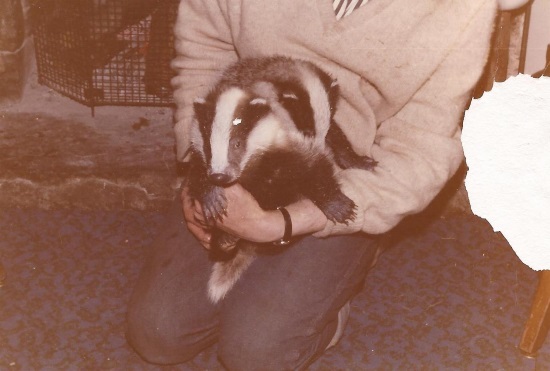
One summer in the mid-1960's, somebody from thereabouts brought two small orphaned badger cubs to Audrey and asked her to take care of them.
She readily accepted the opportunity and tended them devotedly. They were known as Milligan and Fogarty, from the two hapless characters in Spike Milligan's very funny comic novel Puckoon that was hugely popular at that time.
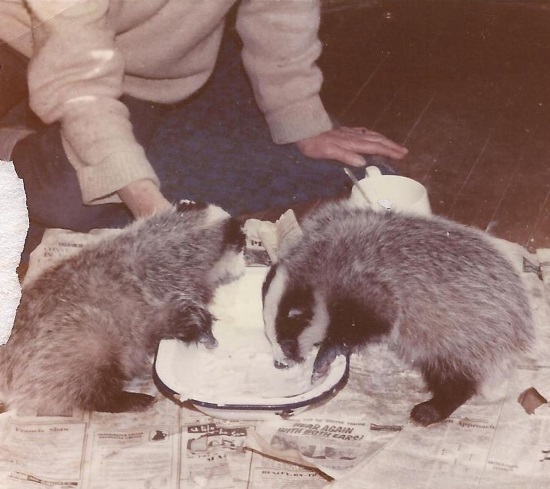
Milligan and Fogarty would come when called, lumber into the hotel bar and greedily consume a high-protein bowlful together, oblivious to the intense interest from all around.
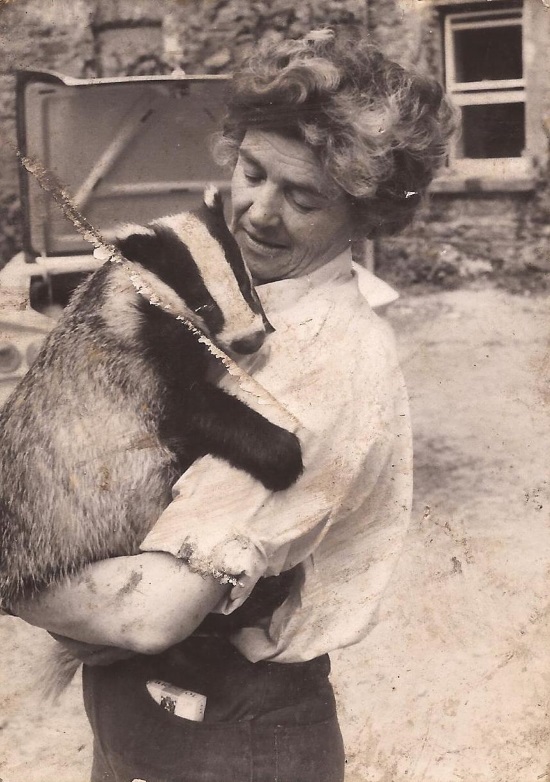
They flourished under her watchful eye, and, as badgers do, grew larger, much larger.
Audrey eventually released them successfully back into the wild, but for quite a while afterwards they would still turn up at the back door of the hotel to say hello.
Christmas Card
Political correctness had yet to reach Ireland, with such blandly uninspiring messages as "Season's Greetings" or (worse still) the transatlantic "Happy Holidays"!
Châtelaine and Seigneur
Q's and A's
This wonderful relic only surfaced quite recently as yet more crates were being unpacked following our house-removal almost two years ago. I'd never seen it before, and was deeply impressed by its effortless accuracy and timeless sense of humour, and the wonderful watercolour illustrations (sometimes reminiscent of Barry Appleby, the cartoonist behind The Gambols, to which these bear more than a passing resemblance, and once or twice Fougasse $ – praise indeed).
It is undeniably scorched and battered, and is indeed lucky not to have been reduced to ashes in the 1968 fire that destroyed Ardnagashel House. Even in its early prime, it was only intended as a jeu d'esprit, and the binding and the covers were likewise pleasantly amateurish.
Sometimes, though, it is our imperfections that make us strangely more attractive (though not in my case, alas) – or more noble, the duellist's scar, the boxer's nose, the rugby player's ears. And in the earlier instance, the actress Julia Roberts' features are undeniably non-standard, but the overall effect is utterly beguiling.
And so, rather than unpicking these pages and scanning them individually, I've scanned them in situ (not easy, believe me). Click to view and see what you think ...
| Front cover |
p1 | p2 | p3 | p4 | p5 | p6 | p7 | p8 | p9 | p10 | p11 | p12 | Back cover |
... or this scrollable version of the complete set.
$ Kenneth Bird took his pen-name from a French anti-personnel mine noted for its erratic performance – just like a cartoon, sometimes it hit the spot and sometimes it didn't. Aunt Jane, indefatigable source of so much slightly untrustworthy family lore, once remarked, in some connection, that her parents Robert and Hannah Waddell had made his acquaintance whilst he was taking a holiday cottage in the Trossachs in the late 1930's. As his back had been badly damaged during the ill-starred Gallipoli campaign years earlier, he could only draw comfortably by being suspended in a hammock slung below a wooden frame which also supported his drawing board upside down above him. Respect!
The Horticultural History
The following historical overview up until 1980/81 is transcribed from
- Miss Ellen Hutchins (1785 – 1815) and the Garden at Ardnagashel, Bantry, County Cork, John Bevan, (46 Foyle Road, Fairview, Dublin 3), published in
- Moorea, The Journal of the Irish Garden Plant Society, p 1, vol 3, Mar 1984 irishgardenplantsociety.com/wp-content/uploads/2013/08/MOOREA-VOLUME-3-MARCH-1984-PDF-7710KB.pdf
which itself (we might call it JB0) is based on the first and second parts of a project entitled Ardnagashel – A Hidden Treasure which the author presented as part of his work for the Certificate in Amenity Horticulture at the National Botanic Gardens, Glasnevin, in 1981.
| Module | Page | Section | Heading |
|---|---|---|---|
| JB1 | Title | Ardnagashel: A Hidden Treasure | |
| Acknowledgements | |||
| 1 | Introduction | ||
| 2 | 1 | ||
| 5 | 2 | Ardnagashel: Its History and Ownership | |
| JB2 | 9 | 3 | Miss Ellen Hutchins |
| JB3 | 14 | 4 | Trees and Shrubs at Ardnagashel |
| 39 | 5 | Conclusion |
Photocopies of all four typescripts have recently (Jan 2015) emerged from the archive of personal documents left by Mrs Audrey Kaulback at her death (Aug 1994), and I've decided to put them into the public domain – which allows Bevan's magnum opus to be appreciated in its entirety.
When Bevan abstracted JB0 from JB1 and JB2 for publication purposes, some of the details were repackaged, so it is well worth reading all three. The fourth, JB4, is very exiguous, as there is no trace of the photographs – though it is just possible that they are still held by the National Botanic gardens. One of these days I might well make enquiry as to whether copies of at least some of these photographs are obtainable.
Meanwhile, for an up-to-date (Nov 2018) assessment of the condition of the estate, its botany and arboriculture, please click here (or here if the link is broken).
Ardnagashel – History and Ownership
To understand Ardnagashel's history, one must go back to the time when the O'Sullivan clans were overlords of what is now called West Cork. In their possession the land was subject to a system of inheritance called Gavail Ciain, succession from father to son. After the Elizabethan wars the area settled down under Owen O'Sullivan who had taken the Queen's side, but during the 1642 Rebellion, either he or his successor fell into disfavour and his lands were confiscated. After the Cromwellian conflict, the O'Sullivan land in the Bantry area was divided between three adventurers who had enlisted, with a promise of payment by land, and this later created a very complicated system of land tenure under sub-tenants.
The Hutchins family from Dorset appear to have been in Ireland from early in the seventeenth century, according to Burke's Landed Gentry (1958). Richard Hutchins served under the Earl of Orrery in 1666, and became one of the Commissioners of Poll Tax. He owned property at Blackrock, near Bantry, during the eighteenth century.
Arthur Hutchins (1770 – 1838) bought the Ardnagashel freehold for £1000 in 1800; it comprised three hundred acres. He proceeded to lay out the estate; pasture land and plantations were included. He probably constructed the ornamental arch which marks the entrance to the property, and also the avenue to the seashore. The fisherman's cottage was rebuilt as a beautiful mansion with mullion windows. Arthur Hutchins put in the stone drains which have assisted in preventing the sort of erosion that is evident in so many other places around Bantry.
One of his problems was the protection of young plants, including plantation trees, from cattle, both his own and those of other people. Enormous walls were built, both to clear and protect the land. Local tradition has it that in exposed areas west of the house, the young trees failed until others were planted to give shelter. A few of these trees, mostly firs, are still there protecting the valley in which many rare trees and shrubs have been growing since Arthur Hutchins' time.
Emmanuel Hutchins (1769 – 1839), Arthur's brother, practised law. He died mysteriously in Damascus while purchasing Arab horses which his groom brought back to Ireland.
Ellen Hutchins (1785 – 1815), a sister of Arthur and Emanuel, was a famous amateur botanist – I will refer to her later. Her interest in botany was later carried on by other members of the family, and many specimens of trees and plants in the present gardens came from Kew. There is a Cedar of Lebanon which might have come back with one of the family from the Middle East.
Samuel Hutchins (1834 – 1915) went to Australia during the 'Gold Rush' and returned to Ireland in 1858 with over one hundred packets of seeds of Australian plants. No plant books or records were kept by the family, but it would be interesting to visit the property 'Fortlands' near Charleville, which belonged to his father, as there are a number of trees and shrubs there that may have links with those planted at Ardnagashel.
Samuel was a younger son and succeeded his brother Emmanuel (1823 – 1880), who was buried in the 'Chillin' or family graveyard on the estate. This is an interesting feature of the property and some of the burial stones can still be seen.
Eventually Samuel Hutchins was succeeded by Capt Richard N Hutchins (1876 – 1915). He was followed in turn by his son, who eventually passed the property to his sister Patricia Hutchins, a writer, who still resides on part of the estate.
The other part of the land was sold in 1947 [1945] to Col and Mrs Kaulback who changed the house into a hotel and renovated the grounds. They planted extensively. The hotel was destroyed by a fire in 1958 [1968], but was later rebuilt as a private dwelling.
In 1970 [1974] the part of the estate owned by the Kaulbacks was sold to a Dutch company [Bofinex], which planned an elaborate holiday complex. The future of Ardnagashel is under its control.
[Footnotes]:
1945: My wife has shown me a telegram, dated 10 Sep 1945, sent by Ron Kaulback from Ireland to his wife Audrey looking after their young daughters back in England, to say HAVE JUST BOUGHT ARDNAGASHEL [STOP] HOPE YOU WILL LIKE IT.
1968: My wife and I (and all concerned) clearly recall that it was in 1968.
1974: It was by 1970 that Col & Mrs Kaulback's house was rebuilt, and a restaurant opened on the seaward side of the yard above. They closed the restaurant at the end of the 1974 season in anticipation that Bofinex would buy their part of the estate, though preserving their tenancy of the house.
It would have been at this stage that Ronald Kaulback had to relinquish the care and maintenance of the horticultural and arboricultural tradition at Ardnagashel that he had done so much to develop and extend, with the indispensible support of Donal Coakley (ca 1919 – 20 Jul 1993), the immensely capable Ardnagashel gardener, for so many years.
Donal's genius intermingled via his son-in-law Peter with that of the O'Sullivans, who figure so prominently in the recent history of the Ilnacullin gardens in Glengarriff Harbour.
(Donal's wife Mary, though youthful as is the traditional Irish way, was equally indispensable in the running of the hotel – whenever a staffing situation, or kitchen crisis, teetered on the edge of catastrophe, Mary would infallibly resolve the problem and soothe the ruffled egos.)
And indeed, it was only two years later, after yet another volcanic marital altercation, that Ron left Ardnagashel for ever. It emerged subsequently that he had been given some very bad advice as to investing the proceeds of selling Ardnagashel, and there was nothing left in the kitty. Whatever the motivation, it opened new chapters for them both. Audrey herself moved to Rossdoon some years later, a picturesque but rather ramshackle property tucked away above the water's edge just outside Glengarriff, not far from the Eccles, whilst Ron remarried and subsequently lived just above the village of Hoarwithy, near Ross-on-Wye in Herefordshire. It was ironic that she, who had retained her English passport, remained in Ireland, whereas he, who had taken Irish citizenship, should have returned to England!
In retrospect, I should imagine that the high-water mark of the Ardnagashel estate was just prior to the fire that destroyed the hotel in 1968. The Kaulbacks' main objectives after that was to re-establish themselves in hastily converted quarters up in the yard, and to organise the building of the new house on the site of the hotel, and then to build and equip the restaurant, to the left hand side of the yard where the drive curves down towards the sea.
The trajectory between 1968 and 1974 would have been at best a 'managed decline', that rather sardonic euphemism. From 1974 onwards it became a complete surrender of the horticultural heritage1, 2 to the forces of nature – letting in the jungle, in Kipling's vivid phrase. The new owners of Ardnagashel (and their various successors since that time) made little or no visible effort to sustain all that generations of the Hutchins family, surmounted by decades of creativity and conservation by Ron Kaulback and Donal Coakley, had so memorably achieved.
And sadly, to this day it remains just that – a memory of what once was. Bevan's report in 1981 still found much to admire, but there have been over three further decades of total neglect since then.
Postscript
From time to time nice new photographs turn up which can’t easily be inserted into the existing Ardnagashel pages. So this is for them!
Inevitably, the pictures are of the new Ardnagashel, but the old must yield to the new.
The extensive further side of the yard, beyond the barn (now repurposed, as seen above) and where the Gypsy caravan eventually came to rest, was put to many different purposes over the years, although it’s difficult to identify them in detail. But certainly, every year, great quantities of hay would be harvested (winter feed for the dairy herd perhaps). Sonia certainly remembers countless buckets of hot tea and great trays of sandwiches (which she and Susie had helped to prepare in the Ardnagashel kitchens) being carried out to the harvesters – some of whom may well have come to help from elsewhere in the district.


